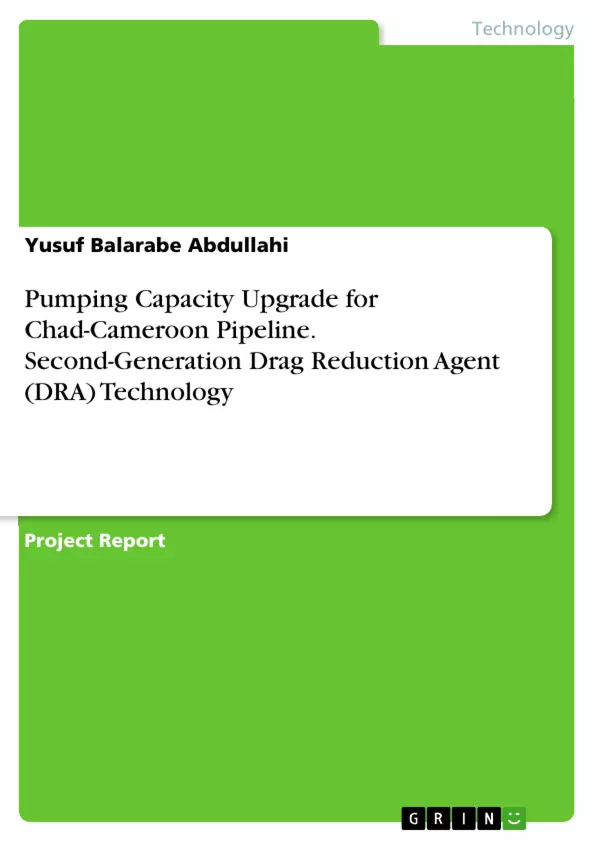This paper examines the idea of increasing the pumping capacity of the Chad-Cameroon pipeline system by using second-generation drag reduction agent (DRA) technology. Evidence shows that it is technologically feasible to upgrade the pipeline system to a capacity of 500,000 barrels per day (bpd) for the cost of $364.4 million. This capacity assumes the use of both the TOTCO and COTCO pipelines, the report also presents several lower capacities, and lower cost options. The upgrades will take at least 42 months to install and commission. The pipeline upgrade has numerous important strategic benefits that can help enhance the Chad-Cameroon pipeline’s reputation as a more stable, and reliable oil producer in the world market.
In total, the Project would consist of approximately 664 miles of new, 36-inch diameter pipeline within the Chad and Cameroon. The proposed Project would have an initial capacity to deliver up to 500,000 barrels per day (bpd) of Doba’s oil field from the proposed Komé crossing to existing oil terminals in Dompla and Belabo. Existing binding commitments for the Project amount to 250,000 bpd of crude oil and as demand for Chad-Cameroon pipeline oil increases, the pipeline would increase its load, up to its initial capacity of 500,000 bpd. The Project could ultimately transport up to 700,000 bpd of crude oil through the proposed pipeline upgrade by adding additional pumping capacity if warranted by future market demand.
The Project requires 18 new pump stations, 36 intermediate mainline valves (MLVs) of which 24 are check valves located downstream of major river crossings, approximately 50 permanent access roads and approximately 30 temporary access roads, one tank farm and two crude oil delivery sites.
Inhaltsverzeichnis (Table of Contents)
- 1. Introduction
- 1.1 Project Objectives
- 1.1.1 Project Outputs
- 1.2 Project Scope
- 1.3 Project Deliverables
- 1.4 Main Risks Associated To Project And Solutions
- 1.4.1 Environmental Impact and Mitigation Measures
- 1.4.2 Operational Phase
- 1.5 Advantages And Justification Associated With Procurement Route
- 1.5.1 The Project Organisation Structure
- 1.5.2 The Project Communication And Reporting Plans
- 1.6 Planned Pipeline Construction Procedures
- 1.6.1 Project Cost Plan
- 1.6.1.1 Project Cost ($ million)
- 1.6.1.1.1 Cost Breakdown by Project Components ($ million)
- 1.6.1.1.2 Project Schedule
- 1.6.1.1.3 Expected Project Performance Report Ratings
- 1.6.1.2 Data on World Bank Group Missions
- 1.6.2 Potential Project Income And Expenditure
- 1.6.2.1 Costs
- 1.6.2.2 Income Tax
- 1.6.2.3 Internal Rates of Return (IRR)
- 1.7 Project Development Plan
- 1.7.1 Project Schedule
- 1.7.1.1 Pipeline from Doba oil field to Cameroon's Atlantic coast at Kribi
- 1.8 Pipe Geometry Inspection, Final Tie-ins, and Commissioning Strategy
- 1.8.1 Pipeline from Doba oil field to Cameroon's Atlantic coast at Kribi
- 1.8.2 Pumps at LPG Input Station and Booster Pumps
- 1.9 Importance of Control and Tools that promote Control
- 1.10 Conclusions
- 1.11 Recommendations
- 1.11.1 Project Related - Future Monitoring
- 1.11.2 Timing of Project Performance Audit Report
- 1.11.3 General
- Reference
- Appendix A - Chronology Of Main Events In Project Implementation
- Appendix B - Cost Breakdown By Project Components
- Appendix C - Project Costs And Summary Of Contracts
- Appendix D - Project Financing Plan
- Appendix E - Projected And Actual Disbursements Of Loan Proceeds
- Appendix F - Project Implementation Schedule
- Appendix G - Organization Chart And Project Implementation Structure
- Appendix H - Economic And Financial Analysis
- Appendix I - Economic And Financial Analysis
- Appendix J - Summary Of Training Courses
Zielsetzung und Themenschwerpunkte (Objectives and Key Themes)
This project aims to enhance the pumping capacity of the Chad-Cameroon pipeline by integrating second-generation Drag Reduction Agent (DRA) technology. This initiative seeks to improve the efficiency and effectiveness of the oil transportation system while considering environmental sustainability.
- Project planning and implementation
- Cost analysis and financial management
- Environmental considerations and mitigation strategies
- Operational efficiency and technological advancements
- Risk assessment and management
Zusammenfassung der Kapitel (Chapter Summaries)
The first chapter delves into the project's objectives, scope, deliverables, and associated risks. It outlines the project's organization structure, communication plans, and a comprehensive cost and schedule breakdown. The chapter also provides an overview of the project's financial planning, including income and expenditure projections.
Chapter two focuses on the project's development plan, outlining the schedule and pipeline route. It further details the inspection, tie-in, and commissioning strategy for the pipeline, including the role of pumps at LPG input stations and booster pumps.
Schlüsselwörter (Keywords)
The document focuses on engineering project management, pipeline construction, Drag Reduction Agent (DRA) technology, cost analysis, financial planning, environmental impact assessment, risk management, and operational efficiency. The key themes include project objectives, scope, deliverables, risk mitigation, cost and schedule management, financial analysis, environmental sustainability, and technology implementation.
- Citar trabajo
- Yusuf Balarabe Abdullahi (Autor), 2021, Pumping Capacity Upgrade for Chad-Cameroon Pipeline. Second-Generation Drag Reduction Agent (DRA) Technology, Múnich, GRIN Verlag, https://www.grin.com/document/1157684



